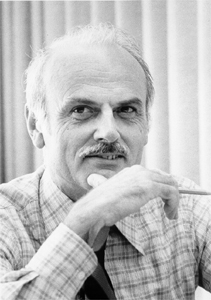A relational database is a database based on the relational model of data, as proposed by E. F. Codd in 1970. A system used to maintain relational databases is a relational database management system (RDBMS). Many relational database systems are equipped with the option of using SQL for querying and updating the database.
The relational model (RM) is an approach to managing data using a structure and language consistent with first-order predicate logic, first described in 1969 by English computer scientist Edgar F. Codd, where all data is represented in terms of tuples, grouped into relations. A database organized in terms of the relational model is a relational database.
Structured Query Language (SQL) is a domain-specific language used in programming and designed for managing data held in a relational database management system (RDBMS), or for stream processing in a relational data stream management system (RDSMS). It is particularly useful in handling structured data, i.e., data incorporating relations among entities and variables.

An object–relational database (ORD), or object–relational database management system (ORDBMS), is a database management system (DBMS) similar to a relational database, but with an object-oriented database model: objects, classes and inheritance are directly supported in database schemas and in the query language. In addition, just as with pure relational systems, it supports extension of the data model with custom data types and methods.
Fabian Pascal is a Romanian-American consultant to large software vendors such as IBM, Oracle Corporation, and Borland, but is better known as an author and seminar speaker. Born in Romania, Pascal lives in the San Francisco, CA area of the US, and works in association with Christopher J. Date.

Chris Date is an independent author, lecturer, researcher, and consultant, specializing in relational database theory.

Hugh Darwen is a computer scientist who was an employee of IBM United Kingdom from 1967 to 2004, and has been involved in the development of the relational model.

Edgar Frank "Ted" Codd was an English computer scientist who, while working for IBM, invented the relational model for database management, the theoretical basis for relational databases and relational database management systems. He made other valuable contributions to computer science, but the relational model, a very influential general theory of data management, remains his most mentioned, analyzed and celebrated achievement.
In database theory, relational algebra is a theory that uses algebraic structures for modeling data, and defining queries on it with a well founded semantics. The theory was introduced by Edgar F. Codd.
First normal form (1NF) is a property of a relation in a relational database. A relation is in first normal form if and only if no attribute domain has relations as elements. Or more informally, that no table column can have tables as values. Database normalization is the process of representing a database in terms of relations in standard normal forms, where first normal is a minimal requirement. SQL-92 does not support creating or using table-valued columns, which means that using only the "traditional relational database features" most relational databases will be in first normal form by necessity. Database systems which do not require first normal form are often called NoSQL systems. Newer SQL standards like SQL:1999 have started to allow so called non-atomic types, which include composite types. Even newer versions like SQL:2016 allow JSON.
Dataphor is an open-source truly-relational database management system (RDBMS) and its accompanying user interface technologies, which together are designed to provide highly declarative software application development. The Dataphor Server has its own storage engine or it can be a virtual, or federated, DBMS, meaning that it can utilize other database engines for storage.
In relational databases, relvar is a term introduced by C. J. Date and Hugh Darwen as an abbreviation for relation variable in their 1995 paper The Third Manifesto, to avoid the confusion sometimes arising from the use of the term relation, by the inventor of the relational model, E. F. Codd, for a variable to which a relation is assigned as well as for the relation itself. The term is used in Date's well-known database textbook An Introduction to Database Systems and in various other books authored or coauthored by him.

In SQL, null or NULL is a special marker used to indicate that a data value does not exist in the database. Introduced by the creator of the relational database model, E. F. Codd, SQL null serves to fulfil the requirement that all true relational database management systems (RDBMS) support a representation of "missing information and inapplicable information". Codd also introduced the use of the lowercase Greek omega (ω) symbol to represent null in database theory. In SQL, NULL is a reserved word used to identify this marker.
Object–relational impedance mismatch creates difficulties going from data in relational data stores to usage in domain-driven object models. Object-orientation (OO) is the default method for business-centric design in programming languages. The problem lies in neither relational nor OO, but in the conceptual difficulty mapping between the two logic models. Both are logical models implementable differently on database servers, programming languages, design patterns, or other technologies. Issues range from application to enterprise scale, whenever stored relational data is used in domain-driven object models, and vice versa. Object-oriented data stores can trade this problem for other implementation difficulties.
Sixth normal form (6NF) is a term in relational database theory, used in two different ways.
David McGoveran is an American computer scientist and physicist, software industry analyst, and inventor. In computer science, he is recognized as one of the pioneers of relational database theory.
Nikos Lorentzos is a Greek professor of Informatics. He is a specialist on the Relational Model of Database Management, having made contributions in the field of temporal databases, where he has co-authored a book with Hugh Darwen and Christopher J Date.
Jakarta Persistence is a Jakarta EE application programming interface specification that describes the management of relational data in enterprise Java applications.
Relational Model/Tasmania (RM/T) was published by Edgar F. Codd in 1979 and is the name given to a number of extensions to his original relational model (RM) published in 1970. The overall goal of the RM/T was to define some fundamental semantic units, at "atomic" and "molecular" levels, for data modelling. Codd writes: "the result is a model with a richer variety of objects than the original relational model, additional insert-update-delete rules and some additional operators that make the algebra more powerful."
In computing, Open Data Protocol (OData) is an open protocol that allows the creation and consumption of queryable and interoperable Web service APIs in a standard way. Microsoft initiated OData in 2007. Versions 1.0, 2.0, and 3.0 are released under the Microsoft Open Specification Promise. Version 4.0 was standardized at OASIS, with a release in March 2014. In April 2015 OASIS submitted OData v4 and OData JSON Format v4 to ISO/IEC JTC 1 for approval as an international standard. In December 2016, ISO/IEC published OData 4.0 Core as ISO/IEC 20802-1:2016 and the OData JSON Format as ISO/IEC 20802-2:2016.




